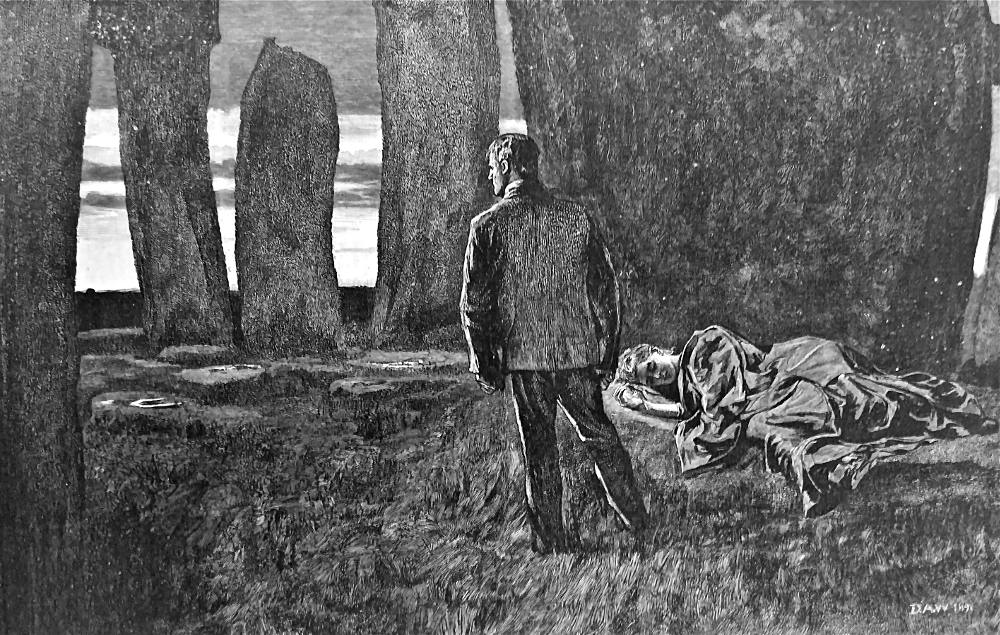
Something seemed to move on the verge of the dip eastward — a mere dot. It was the head of a man approaching them from the hollow beyond the Sun-stone. Clare wished they had gone onward, but in the circumstances decided to remain quiet. The figure came straight towards the circle of pillars in which they were. by D. A. Wehrschmidt in the London Graphic (26 December 1891), page 759, plate 24. Whole-page (19.5 cm high x 30.4 cm wide, or 7 ⅞ inches high by 12 ⅜ inches wide), p. 759; incident illustrated, p. 761, two-thirds of the way down column 1 (end of Ch. LVIII). [Click on the image to enlarge it.]
Passage Illustrated: The Couple Cornered at Stonehenge
Like a greater than himself, to the critical question at the critical time he did not answer; and they were again silent. In a minute or two her breathing became more regular, her clasp of his hand relaxed, and she fell asleep. The band of silver paleness along the east horizon made even the distant parts of the Great Plain appear dark and near; and the whole enormous landscape bore that impress of reserve, taciturnity, and hesitation which is usual just before day. The eastward pillars and their architraves stood up blackly against the light, and the great flame-shaped Sun-stone beyond them; and the Stone of Sacrifice midway. Presently the night wind died out, and the quivering little pools in the cup-like hollows of the stones lay still. At the same time something seemed to move on the verge of the dip eastward — a mere dot. It was the head of a man approaching them from the hollow beyond the Sun-stone. Clare wished they had gone onward, but in the circumstances decided to remain quiet. The figure came straight towards the circle of pillars in which they were.
He heard something behind him, the brush of feet. Turning, he saw over the prostrate columns another figure; then before he was aware, another was at hand on the right, under a trilithon, and another on the left. The dawn shone full on the front of the man westward, and Clare could discern from this that he was tall, and walked as if trained. They all closed in with evident purpose. Her story then was true! Springing to his feet, he looked around for a weapon, loose stone, means of escape, anything. By this time the nearest man was upon him. [Book Seventh, "Fulfilment," Chapter LVIII, pp. 760-761; in the 1897 volume edition, 515]
Scanned image and text by Philip V. Allingham. Formatting by George P. Landow. [You may use this image without prior permission for any scholarly or educational purpose as long as you (1) credit the person who scanned the image and (2) link your document to this URL in a web document or cite the Victorian Web in a print one.]
Commentary: Tess Sacrificed to the Patriarchy at the Altar Stone
The picture, of course, does not realise the police apprehension of Tess for the murder of Alec D'Urberville. Rather, in Angel's vigilance Wehrschmidt prepares us for the climactic arrest of the murderess at Stonehenge. Although he has communicated well the phallic shapes of the neolithic pillars and created a theatrically effective set for the culmination of Tess's attempted escape that climaxes the action of the ultimate, December 26th instalment, the illustrator has failed to provide emotionally-engaging or even animated characters. Instead of being compelled by his vantage point to identify with Clare (as Hardy has his readers do by describing the arrival of the police from Angel's perspective), Wehrschmidt has theatrically distanced his viewers, as if they are watching the final scene in the tragedy from a comfortable seat in the lower orchestra. As Jackson notes, Wehrschmidt has missed a glorious opportunity to depict convincingly one of the novel's most dramatic moments. Here, the viewer has neither a sense of "the whole enormous landscape" (LIVIII: 761) of the Salisbury Plain that lies beyond the ancient shrine, nor a proper sense of "the great flame-shaped Sun-Stone," from the hollow of which the first of the pursuers appears. Clare, too "nondescript and too unlike his image in earlier illustrations" (Jackson 112), seems to be but another of the phallic pillars surrounding the sleeping Tess. The similarity between Angel's back and the neolithic pillars is an appropriate reminder that his earlier, hard-hearted rejection of Tess has led to her present predicament. Ironically, although Tess is sleeping under Angel's overcoat on the Altar Stone, the viewer feels little apprehension about her fate. The large-scale plate fails aesthetically because it does not compel the viewer's sympathy for the diminished form, as Wehrschmidt makes the dominant, masculine figure of Angel Clare his focal point.
Bibliography
Allingham, Philip V. "The Original Illustrations for Hardy's Tess of the D'Urbervilles Drawn by Daniel A. Wehrschmidt, Ernest Borough-Johnson, and Joseph Sydall for the Graphic (1891)." The Thomas Hardy Year Book, No. 24 (1997): 3-50.
Hardy, Thomas. Tess of the D'Urbervilles in the Graphic, 1891, 4 July-26 December, pp. 11-761.
Hardy, Thomas. Tess of the D'Urbervilles: A Pure Woman. Vol. I. The Wessex Novels. London: Osgood, McIlvaine, 1897.
Jackson, Arlene M. Illustration and the Novels of Thomas Hardy. Totowa, NJ: Rowman and Littlefield, 1981.
Last updated 9 May 2025